Arunachaleswara Temple, spread over 24 acres, is the largest Siva temple in India, and smaller only to the Vishnu temple of Srirangam in Tiruchirappalli, Tamil Nadu. Arunachaleswara is said to be at least 2000 years old, with the gopurums (towers) and stone structure dating back 1200 years. This dating is from an inscription in the structure that was made during the reign of the Chola kings who ruled in the ninth century A.D.
A description of the temple, from GloriousIndia.com:
When we observe the general structure of the temple, we notice that there are five small gopurams on the inner boundary and four big gopurams on the outer boundary. The inner gopurams are known as Kitti gopurams. There are two gopurams in the East and one gopuram each for the other three directions. The first of the two Eastern gopurams is called Kili gopuram. There are indications that this was built in the 11th century. The gopurams built during this period have no more than five stories. The Kili gopuram was built by Veera Rajendra Chozhan around 1063 A.D. He is referred to as Maharaja Thiribuvana Chakravarthigal in the inscription.This name was also given to the gopuram. The Kitti (smaller) gopurams, except the top of the western one, were built by the Hoysala King Vallala Maharaja III. His name is given to the biggest Kitti gopuram which is in the East.
In the satellite photo (from Google Earth) below, you can see the nine gopurams. You can also see the two tanks, dark, in the bottom center and right. The Thousand Pillared Hill is in the upper right. Two interior walled compounds are visible on the left, one within the other. In the middle of the interior compound sits the main temple. Arunachaleswara Temple grew over the last 2000 years, from a thatched hut over the main shrine, to temple with stone walls, to encompass the inner compound, to the middle compound, and finally into the whole site that still exists to this day.
Arunachaleswara Temple and Sri Ramana Maharshi
Arunachaleswara Temple is where Sri Ramana Maharshi initially stayed when he came to Tiruvannamalai in 1896. He lived there for about six months, until he moved to the small temple of Gurumurthan, encouraged to do so by Annamalai Tambrian. It was at Arunachaleswara that the young boy (Ramana) was first recognized as the embodiment of Hindu scriptures by some who saw him. He was given the name of Brahmana Swami by Seshadriswami, another young saint living at the temple.
Sri Ramana is associated with several locations within Arunachaleswara. First was the Thousand-Pillared Hall, where Sri Ramana lived and sat for some weeks initially, until the harassment from young boys caused him to relocate to the Patala Lingam, in a dark chamber underneath the Thousand-Pillared Hall. He sat in the southeast corner, where the stones thrown by the urchins could not reach him. They were afraid to enter this area, due to the darkness, and would just pelt him from the entrance. After being physically removed from the Patala LIngam by devotees, concerned at the terrible ravages dealt the the upper body and legs of Sri Ramana, he lived for a few weeks in the Subramanaya Shrine, cared for by a small group of ascetics, then moved to the nearby garden where he lived in the shade of the oleander shrubs. Finally he moved to the Vahana Mantapam, the hall where the vehicles used for processions of the gods were kept, staying there hidden underneath the chariots.
A good write up of Sri Ramana’s early days at Arunachaleswara Temple can be found here. from Gabriele Ebert’s, book, Ramana Maharshi: His Life.
Visiting Arunachaleswara Temple
We took a trip to the Big Temple (as Arunachaleswara Temple is often called by locals in Tiruvannamalai) on Thursday, April 30th, 2009.
We parked our two wheelers by the Eastern Tower, the Raja Gopuram.
After we have left our shoes, we join the crowd entering the gate.
the Killi Gopuram is visible from the gate.
To the right is the Thousand-Pillared Mandapam.
This was an auspicious wedding day, and many wedding parties were at the temple, going to one of the two marriage halls. Brides, grooms, and wedding families packed the temple grounds inside the main gate.
Kambattu Elayanre Murugan Temple
This is the first temple after you enter the Eastern Gate. It is also called Kambattu Elayanar Sannathi. This magnificent Sannathi was built by King Krishnadevarayar. Murugan is especially well loved in South India, so it is not surprising to see this temple first after entering.
Siva Ganga Tirtum
A statue of Siva is first seen, then the tank.
This tank is quite large.
From the eastern end of the Siva Ganga Tirtum, a wonderful view of the temple can be seen, with Arunachala behind. This photo was taken by Saravanan, the Arunachala Mountain and Temple Guide who guided us on this tour. To get the photo, he climbed over the fence and walked to the southeastern end of the tirtum.

Here is the Raja Gopuram from the tank. This gopuram is said the be the second tallest in India.
Lining the roof of the Kambattu Elayanre Murugan Temple are a number of relief scupltures showing elements of various Murugan stories.
Below are close up views of two of these. If anyone knows the stories that are depicted, let me know.
Sarva Siddhi Vinayaka Temple
This Ganesh temple is where Sri Ramana stayed for a few weeks after he was lifted from Patala Lingam.
The sculpture at the entrance shows just how ornate these entryways are. In the center are Siva and Parvati, riding Nandi.
The Big Nandi
As we walk towards the Thousand PIllared Hall, we walk by the Big Nandi, who faces the main inner sanctum of the temple.
Thousand Pillared Mandapam
Into the Thousand-Pillared Hall we go. By the entrance are a few monkeys.
We can see a faint picture of Sri Ramana in the doorway.
Here is Ramana, greeting us as we enter the hall.
Near the entrance to the hall is the entrance to Patala Lingam, where Sri Ramana went to avoid the stone-throwing children.
Entrance to Patala Lingam. We cannot take photos inside. Down the stairs is the Patala lingam. A priest is offering puja to the lingam as we visit it.
This part of the hall has old photos on the wall. Below is one that shows the unmaintained condition of the Thousand-PIllared Hall during the time that Sri Ramana knew it.
Behind the Patala LIngam is a wall between the pillars, separating this part of the hall from the rest of it.
The Thousand-Pillared hall was built by Chola king Krishna Deva Raya. The exactly 1000 pillars are inscribed with the sculptures of the Naik period. King Krishna Deva Raya would sit in this hall and receive visitors.
There is a short wall set up in this area. Something is being constructed. Perhaps it is some kind of museum, as is in Meenakshi Temple in Madurai?
Looking towards the entrance to the hall. Saravanan is in this photo.
Sri Ramanasramam did a major renovation of the Patala Lingam in 2002. This plaque marks that renewal.
Coming from the hall, we see many people gathered for weddings.
There are two Marriage Halls in the temple. Both will be used to capacity today.
We head west, towards the Killi Gpouram.
We then go into lesser known areas. We turn right going up the stairs towards Killi Gopuram. Then turn right again into a small hallway that leads into the next area.
In this area are two Ganesh temples, and a number of primitive Naga shrines.
We come to the first temple. There is Ganesh, adorning the top of the shrine.
Ganesh’s vehicle, or Vahana, is a rat, here seen facing the temple.
Ganesh sits in the Temple, nicely dressed in dhotis.
Outside this temple are a set of primitive statues, covered with yellow turmeric.
Below is a second group of statues. Here they are all Nagas (snake gods, specifically cobras).
Below, the ancient Vahana at the second Ganesh shrine.
The second Ganesh.
More Nagas, covered with Turmeric and dotted with kumkum.
Near these shrines is the Temple Manager’s Housing. This is in a quiet spot, rarely visited by the throngs that come through the temple each day.
Here is the north gopuram, Ammani Annam Gopuram.
The Temple Garden
To the west of Ammani Annam Gopuram is the Temple Garden where flowers for pujas are grown. Ramana stayed here for a period, in the shade of oleander shrubs. He would fall asleep under one shrub and awaken under another, with no memory of moving between them.
Passing through a gate, back into the main area of the temple.
The two southern gopurams are seen from this gate.
We turn to the right and pass by the Music Training Hall.
Then we head west, down a palm tree lined path.
There is another samadhi of a South Indian monk, the Jiva Samadhi.
Western Gopurams
As we pass by, the western gopurams tower over us.
Looking out the gates in the towers.
Siva’s Feet
Next to the Western Gopuram is a small shrine that contain Siva’s feet.
Here are the feet, garlanded with jasmine, to the left, with a small Nandi to the right.
Ardhanariswara Shrine
Next to Siva’s Feet is a small shrine to Ardhanariswara, Siva and Parvati joined as one. This joining is one of the special stories of Arunachala.
Here are Siva and Parvati, with Vishnu’s swan above and Brahma’s boar below.
Below is the inner shrine in the temple.
Ganesh with reverse trunk twist – Valen Puri Vanayaka.
Vinayaka is the deity who removes all bad qualities, instills good qualities and confers peace on the devotee who meditates on him. ‘Vinayaka’ means that he is totally master of himself. He has no master above him. This Vanayaka with a right twisted trunk is a special form, to whom people turn when they need special help.
Valen Puri Vanayaka is all-powerful, even controlling the nine planets.
On the north side of the compound is the Temple cow shed, in an area shaded by coconut palms.
New Moon Temple is where Shakti is taken during the new moon. During this time she has great powers, and is brought here so that these powers are available to those that need them.
Arunagirinatha Samadhi
Arunagiri is a 15th century Tiruvannamalai saint, known today largely because of his many writings. His nine works were Kandar Anubuthi, Kandar Alankaram, Kandar Andhathi, Thiruezhukuttrirukkai, Vel, Mayil, Cheval viruthangal and Thiru Vaguppugal. He was a sinful man, saved by Murugan. His works praise Murugan, and talk about being saved from his sinful ways, by teachings that pointed to the direct experience of the Self. Among other stories is one that Arunagiri was turned into a parrot, a bird that still inhabits the Killi Gopuram.
His shrine has a colorful painted ceiling.
Below is Arunargiri shrine, with Arunachala in the background.
Atop the shrine are Siva and Parvati, with Nandis on both sides.
The western towers, with Arunachala in the background.
Kalyana Mandipam
This hall is where Annamalai and Unammalai are brought during Deepam. This is also where the chariots are housed, and where Ramana stayed for a bit in 1897.
Siva and Parvati adorn the entrance, riding Nandi.
Lights hang from the ceiling of the mandipam.
Chariots for the gods sit on the sides of the hall.
Ancient pillars, inscribed with images as old as India.
Among the stones of the floor of the temple are a number with inscriptions. These were parts of ancient buildings that were torn down to make way for newer structures. Archeologists have read many of these to reconstruct the history of the temple before about 1000 AD.
Below is another chariot, big and heavy. It takes many more than 20 men to even pick this up.
An ancient lingam and Nandi on the temple grounds.
Below is an image of Dakshinamoorthy, being worshiped by a devotee. Thursday is the day of the week for worship of Dakshinamoorthy, and in the Dakshinamoorthy temple near Sri Ramanasramam today there will be many people lined up outside, awaiting their opportunity for darshan with this primordial guru.
From this area, on the other side of Kalyana Mandipam, is a small shelter. During Deepam, one part of the rites is that a small boy with an offering, runs three times from Kalyana Mandipam to this shelter, hiding, before he can make the offering to the gods.
Siva’s Mirror is on the wall here, framed in green. During Deepam it is opened, so Siva can look in it.
The Main Shrine
A Ganesh shrine is to the left of the massive structure.
Annamalai Shrine entrance. Here people prostrate themselves. They always do it here turned to the right, never facing the shrine.
More paving stones with carvings and writings from an earlier era.
We leave the inner enclosure, heading to the Temple elephant.
The doors pictured below are among those that were somehow open when Sri Ramana first entered Arunachaleswara. As he left, we are told that they closed and locked themselves behind him.
Brahma Tirtam
We look over Brahma Tirtam to the Southern towers. The higher one is Tirumanjana Gopuram.
Blessed by the Elephant
When a coin is placed in his trunk, the elephant will provide a blessing. Here is Richard being blessed.
An newly married couple gets blessed by the elephant after their marriage. Very auspicious!
Kala Bhairava
The Kala Bhairava shrine retells an ancient part of Hindu scripture.
Brahma has an extra head (five) and so thinks he is as powerful as Siva. I guess too many heads mean way too much ego!
Siva is called to help solve the problem.
Siva gives special power to Kala Bhairava to deal with Brahma.
Kala Bhairava uses his powers to take the extra head from Brahma. Bhairava is shown carrying the amputated head of Brahma. Cutting off Brahma’s fifth head made him guilty of having slain Brahma, and as a result, he was forced to carry around the head for years until he had been absolved of the sin.
Here is Kala Bhairava in the shrine.
Wedding Parties
On this special wedding day many couples come to be married here. This is the best place for a marriage, carrying the blessings of Siva and Parvati.
This is the Veda Patsala, the school where young Brahmins are trained in the vedas.
Statue of Monk, in a gate
The Eastern Gate ahead
Crowds for the weddings.
The Wedding Halls are very busy.
A couple stands for a photo before their wedding.
Map of today’s walk
We started in the Eastern Gate, to the left. Then we went to the Siva Tirtam, then to the Thousand-Pillared Hall. We then went to the northside to areas most people do not visit, then through the coconut trees to the several shrines at the west end of the temple. We then made our way out through the main temple compound, past the Brahma Tirtam, the Marriage Halls, then back out the Eastern Gate.
Click on buttons below to SHARE or LIKE this posting
Related Posts
To see more similar posts that you may be interested in, please look at these links:
Bhagavan Sri Ramana Maharshi Timeline and Places
Temples, Shrines, and Ashrams in South India
Touring and Travel in India







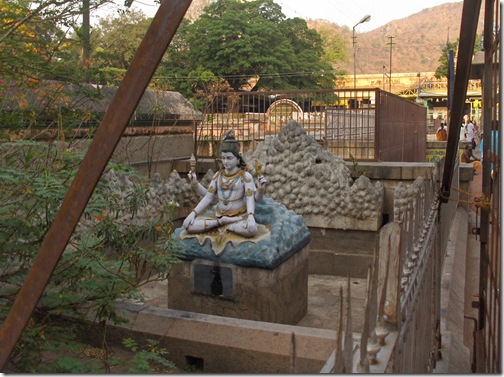



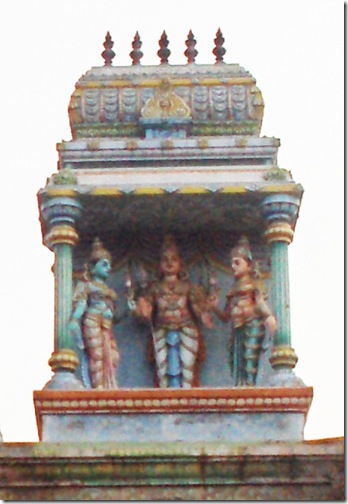













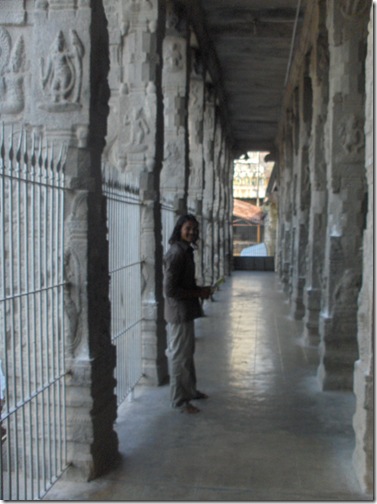






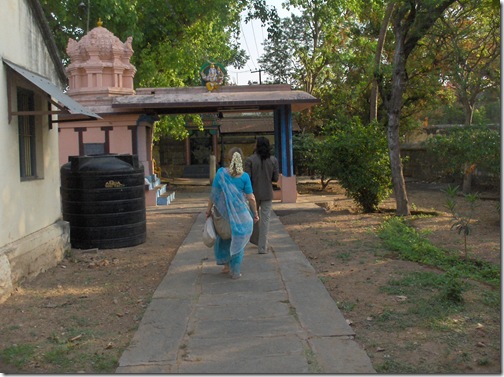












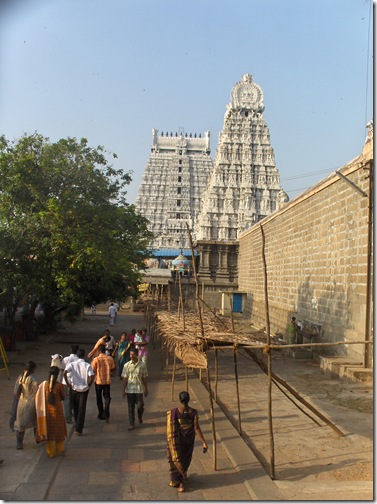



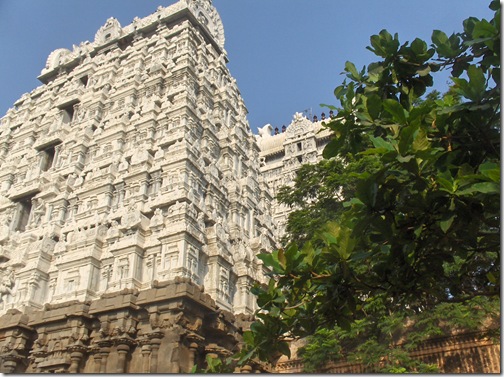




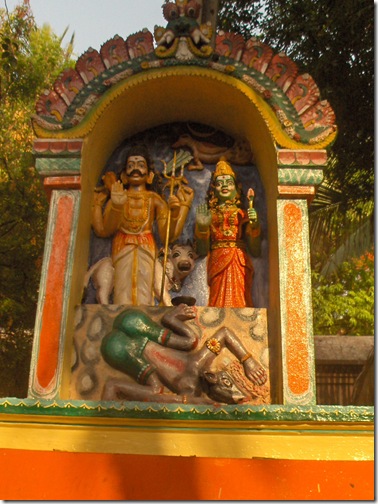



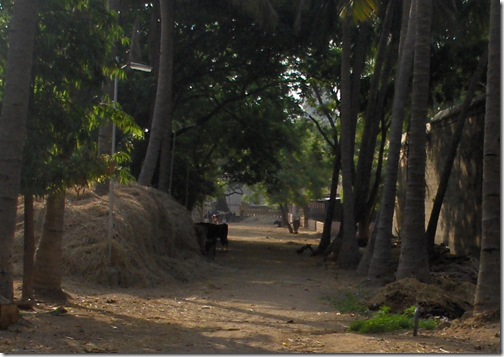







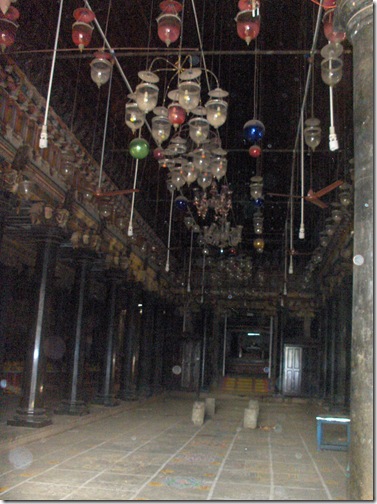



























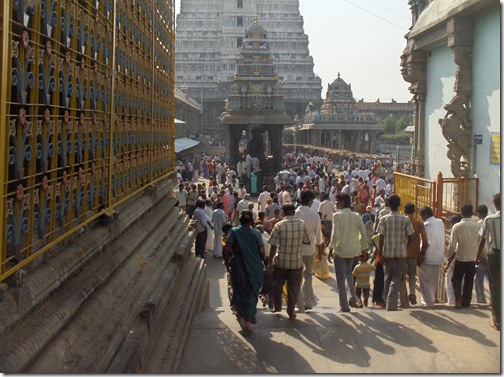



August 19, 2014 at 2:42 pm |
A detailed trip to Sri Arunachaleswarar temple.
The first picture is Sri Murugan / Subramaniyar with his consort Valli and Deivanai.
The second one is Lord Sri Murugan / subramaniyar blessing Avvaiyar one of the great Tamil poet.
Regards
December 30, 2013 at 7:50 am |
Dear Richard,
I would say this is an excellent piece of work and feels like visiting Arunachala. Only a small issue – Krishna Deva Raya is not a chola King as mentioned. Cholas were about 600 years before him.
December 1, 2013 at 11:38 am |
At long last I completed & published my blog post! Please review at bsvprasad.wordpress.com.
December 1, 2013 at 12:29 am |
[…] Here is a link to Richard’s blog post which provides good views of various shrines and other features inside the temple compound. […]
November 1, 2013 at 2:30 am |
[…] 1896 Arunachaleswara Temple […]
August 2, 2012 at 12:26 pm |
[…] Arunachaleswara Temple […]
July 15, 2012 at 11:37 am |
[…] 1896 Arunachaleswara Temple […]
May 14, 2012 at 2:41 pm |
Richard,
I am writing a blog on Tiruvannamalai – can I link to or mention your posts in my blog? Pl let me know. Thanks,
BPrasad
May 14, 2012 at 3:48 pm
Yes, of course.
December 9, 2011 at 11:18 pm |
beautiful
September 22, 2011 at 1:32 am |
Very beautiful narrative & illustrative pictures with suitable commentaries
March 1, 2010 at 9:44 pm |
I am not sure as to who has constructed the 1000 pillared hall; but KrishnaDevaraya is not a Chola king; he is belongs to Nayakkar of VijayaNagara in Andhra/Karnatak border.
Muruga’s picture: I think the first one is Muruga with his 2-consorts. In the second one, Avvai is being blessed by Muruga.
March 2, 2010 at 4:41 am
Thank you for this information.
May 6, 2009 at 7:55 am |
Fantastic. I have never seen a more detailed travelogue on Arunachaleswarar. Great effort. Though I have visited many times, from your post, I come to know about many sacred spots which I have not visited.
You can also look at my travelogues here:
http://shanthiraju.wordpress.com/
Regards,
Raju
May 4, 2009 at 6:30 pm |
[…] Visiting Arunachaleswara Temple in Tiruvannamalai « Living in the … […]
May 1, 2009 at 11:55 pm |
Excellent Richard.
thanks
prashant
http://www.prashantaboutindia.blogspot.com/
May 1, 2009 at 11:14 pm |
Thank you Richard,very nice photographs.